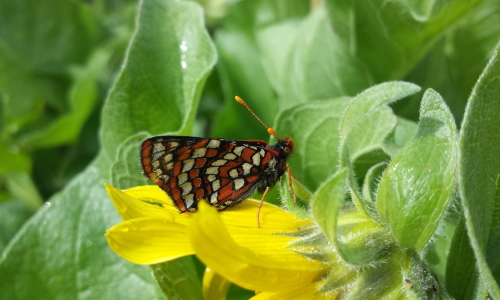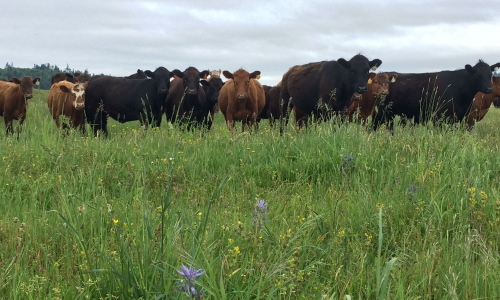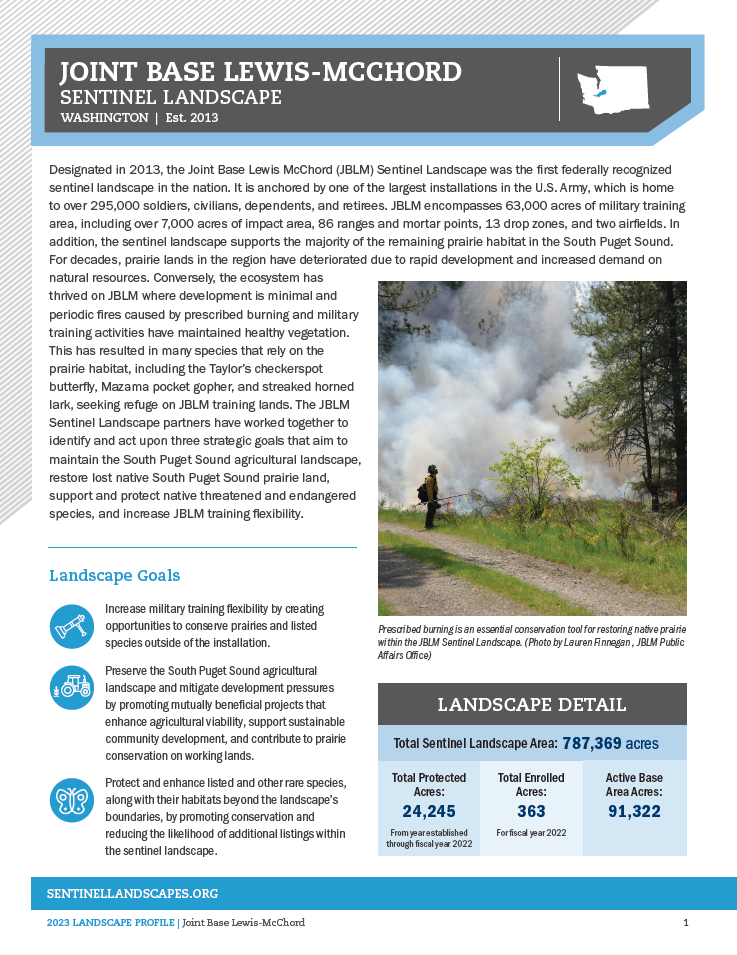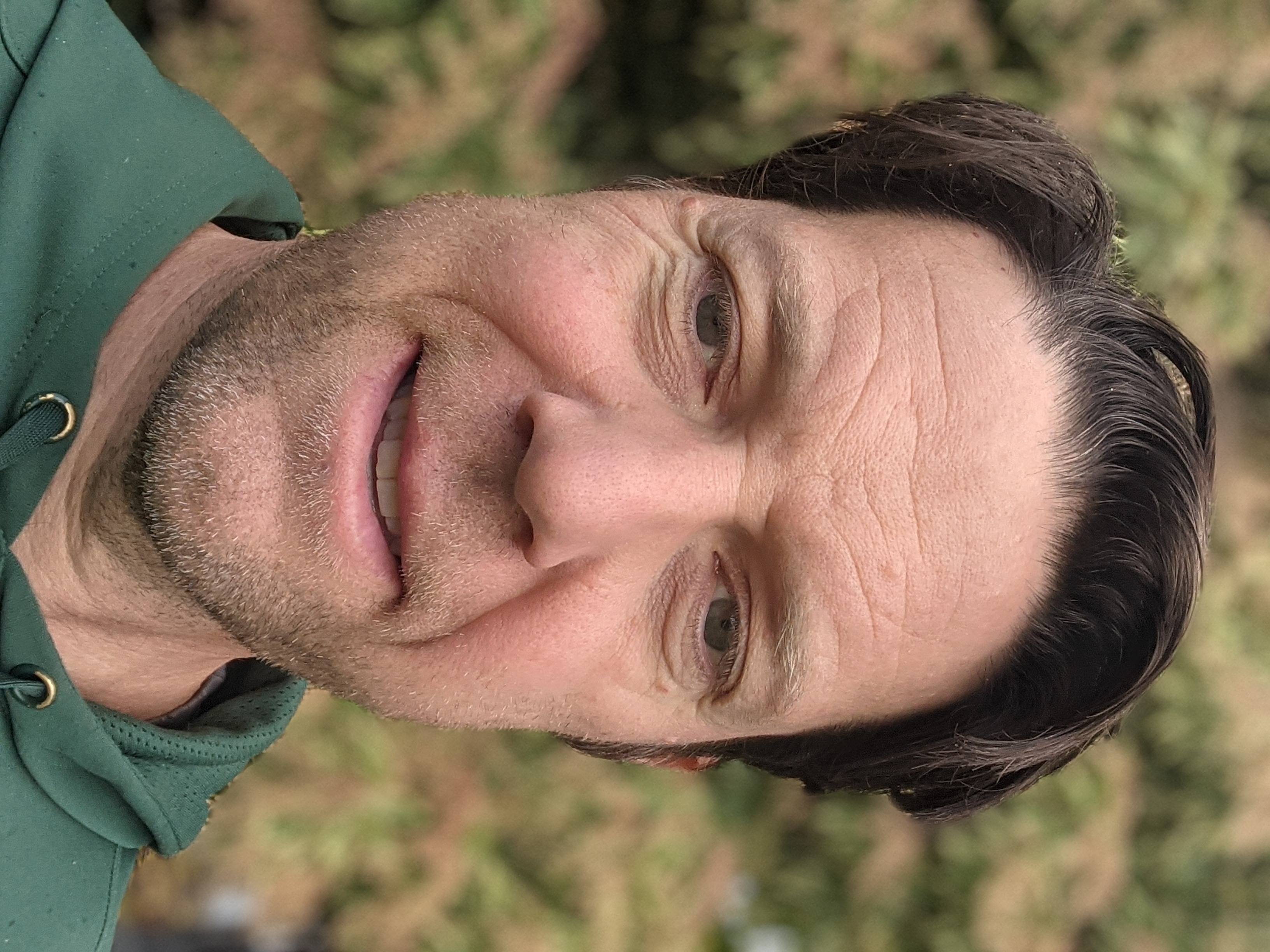Joint Base Lewis McChord Sentinel Landscape
-
Washington
-
Established 2013
About
The Joint Base Lewis McChord (JBLM) Sentinel Landscape is anchored by the third largest installation in the U.S. Army, which is home to 43,000 soldiers and airmen. JBLM encompasses 63,000 acres of military training area, including over 7,000 acres of impact area, 86 ranges and mortar points, 13 drop zones, and two airfields. In addition, the sentinel landscape supports the majority of the remaining prairie habitat in the south Puget Sound. For decades, prairie lands in the region have deteriorated due to rapid development and increased demand on natural resources. Conversely, the ecosystem has thrived on JBLM where development is minimal and periodic fires caused by prescribed burning and military training activities have maintained healthy vegetation. JBLM Sentinel Landscape partners have worked together to enact conservation measures to strengthen military readiness through the recovery of threatened and endangered species.
Interactive Landscape Map
Total Funding by Partner
| Partner | FY2012 | FY2013 | FY2014 | FY2015 | FY2016 | FY2017 | FY2018 | FY2019 | FY2020 | FY2021 | FY2022 |
|---|---|---|---|---|---|---|---|---|---|---|---|
| USDA | $0.58M | $0.54M | $0.26M | $4.26M | $0.62M | $7.71M | $5.25M | $0.47M | $0.0M | $2.00M | $0.0M |
| DoD | $1.50M | $6.50M | $1.61M | $1.75M | $0.75M | $0.00M | $0.00M | $4.56M | $0.54M | $0.0M | $0.0M |
| DOI | $1.46M | $1.34M | $0.51M | $5.65M | $7.48M | $2.81M | $0.43M | $2.75M | $0.74M | $6.29M | $1.04M |
| State | $0.57M | $0.39M | $0.28M | $0.43M | $0.37M | $0.16M | $0.63M | $0.00M | $0.00M | $0.00M | $0.0M |
| Local | $0.08M | $0.98M | $1.49M | $1.51M | $0.66M | $0.87M | $0.45M | $0.00M | $0.15M | $0.03M | $0.0M |
| Private | $1.20M | $1.93M | $1.04M | $1.53M | $0.00M | $0.00M | $0.03M | $0.00M | $0.00M | $0.00M | $0.0M |
Total Acres Protected and Enrolled
| Acres Protected (Since Designation) | 22098.00 |
|---|---|
| Acres Enrolled (During FY22) | 363.00 |
Partnership Highlights

Strengthening Military Readiness through Endangered Species Recovery
Despite once extending over 150,000 acres, prairie habitat native to Washington State’s Puget Sound now covers only 23,000 acres, 90 percent of which is located on JBLM. As a result, multiple species listed under the Endangered Species Act (ESA) that depend on the habitat—such as the Taylor’s checkerspot butterfly and the Mazama pocket gopher—seek refuge on the installation. Throughout 2019, JBLM continued to support the recovery of these species. Populations of Taylor’s checkerspot butterfly expanded on JBLM due to relocation efforts and habitat management actions taken by the U.S. Army. In fact, in 2019, the Washington Department of Fish and Wildlife recorded the highest number of butterflies at the species’ source site on JBLM to date. In recognition of Taylor's checkerspot butterflies’ improving status on the installation, the U.S. Fish and Wildlife Service (USFWS) and JBLM amended their programmatic biological opinion to relax several of the restrictions on military training activities that were previously activated by the ESA. JBLM is also working to open a section of prairie habitat on the base that the U.S. Army will manage with prescribed fire and invasive plant control, which is expected to increase pocket gopher populations. Off base, partners conducted similar habitat improvement projects across the sentinel landscape. In 2019, USFWS restored 67.5 acres and maintained 129 acres of prairie habitat through its Partners for Fish and Wildlife Program. Likewise, the Washington Department of Fish and Wildlife restored 373 acres of prairie habitat. Lastly, USFWS partnered with the U.S. Department of Agriculture’s (USDA) Natural Resource Conservation Service (NRCS) to hire a full-time biologist to support species recovery across the landscape.

Advancing Conservation Opportunities on Agricultural Lands
In 2018, a group of farmers, ranchers, academics, and county governments formed a research collaborative to determine whether certain agricultural practices can help restore Washington State’s rapidly deteriorating dry prairie habitat. Using a grant from the USDA’s Western Sustainable Agriculture Research and Education Institution, the team evaluated the impacts of conservation grazing practices on native plant communities, federally threatened gophers, and rare butterflies on three ranches across the JBLM Sentinel Landscape. The team consists of representatives from the Center for Natural Lands Management, Washington State University, the University of Idaho, USDA NRCS, and Thurston County. Using the data collected from the effort, the partners hope to demonstrate the economic and ecological benefits of conservation grazing practices. If successful, this would expand the government benefits available to working landowners for habitat management. The group has already begun to share findings with the local farming community through a well-attended workshop series.
Our Partners
State Partners
- University of Washington
- Washington Department of Corrections
- Washington Department of Fish and Wildlife
- Washington Department of Natural Resources
- Washington Department of Veterans Affairs
- Washington State Conservation Commission
- Washington State Department of Agriculture
- Washington State University Extension
Private Partners
- Capitol Land Trust
- Center for Natural Lands Management
- Ecostudies Institute
- Enterprise for Equity
- Evergreen State College, Sustainability in Prisons Program
- Nisqually Land Trust
- Northwest Rangeland Trust
- Oregon Zoo
- PCC Farmland Trust
- South of the Sound Community Farmland Trust
- Wolf Haven International
In The News
-
Endangered Butterflies Rebound in South Sound Prairies
In this article, Nisqually Valley News examines how scientists at the Washington State Department of Fish and Wildlife collaborated with Joint Base Lewis McChord to successfully reintroduce the endangered Taylor’s checkerspot butterfly into the South Sound prairies.
Read More -
‘Conservation grazing’ uses cattle to preserve species and landscapes
Using livestock to benefit the environment is called conservation grazing. It relies on timing — when and how long cattle are on specific pastures — to ensure the animals do more good than harm. Click below to learn how cattleman in Olympia, Washington deploy their animals with this goal in mind.
Read More -
In Time for Endangered Species Act’s Golden Anniversary, a Golden Flower is Recovered
As the Endangered Species Act turns fifty years old, it has brought about a conservation success story in the Pacific Northwest. Prairies in Washington and Oregon are once again colored with the bright flowers of golden paintbrush. The U.S. Fish and Wildlife Service (Service) finalized a rule to delist the previously rare plant from the Endangered Species Act (ESA) due to recovery. Click below to read more.
Read More -
Collaboration Across Conservation and Agriculture in western Washington
With recent ESA listings resulting from habitat loss, a team of farmers, researchers, and county planners is seeking to build collaboration across conservation and agriculture. Click below to read more.
Read More
Resources
-

2023 Joint Base Lewis McChord Sentinel Landscape Profile
Meet the Coordinator

Dan Calvert, PhD
Dan Calvert coordinates the Joint Base Lewis McChord Sentinel Landscape Partnership which brings together partners in working lands, conservation, and the military to advance innovative conservation and community goals. Dan’s career has focused on finding shared values to tackle wicked natural resource management issues. Recognizing the interconnections between human and natural systems and supporting collaborative integrated projects are key values to him. He earned a PhD from Oregon State University and BS from the University of Oregon. In his free time Dan can be found hiking, biking, rafting, skiing, and finding other ways to spend time outside with his wife and two daughters. A self-identified locavore, he spends a lot of time fishing, foraging, gardening, hunting and supporting local food systems in the South Sound region.
“Thurston Conservation District supports the mission of the Joint Base Lewis-McChord Sentinel Landscape because it embodies the mission and values of our organization – to work with private landowners and partners to protect our vital agricultural economy, while conserving endangered species habitat. Engaging our military community in agricultural and conservation efforts in our region provides a strong pipeline of stewards of our South Puget Sound’s valuable natural resources, while also ensuring our that these important landscapes are preserved for future generations. We value the inclusion of our local landowner and agricultural community in our local Sentinel Landscape, where their needs and barriers are included in project development and execution. This is critical to the success our region’s shared goals!”